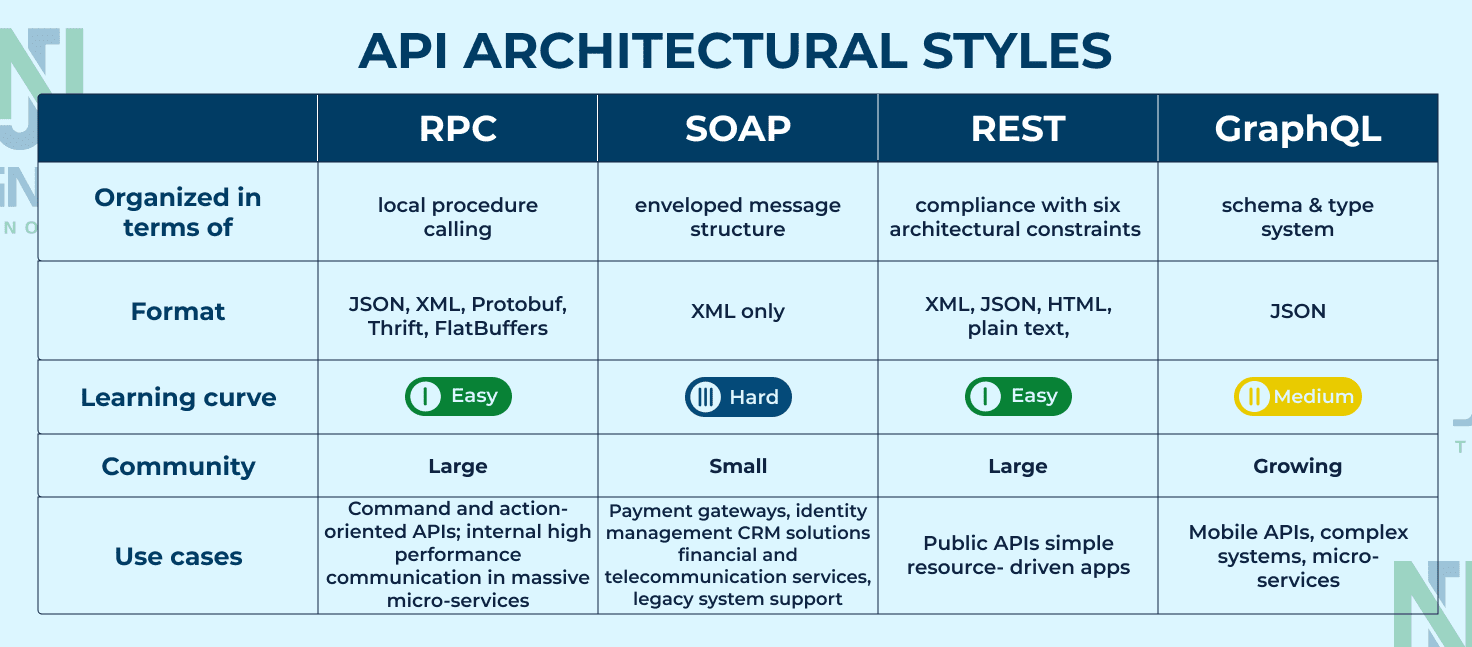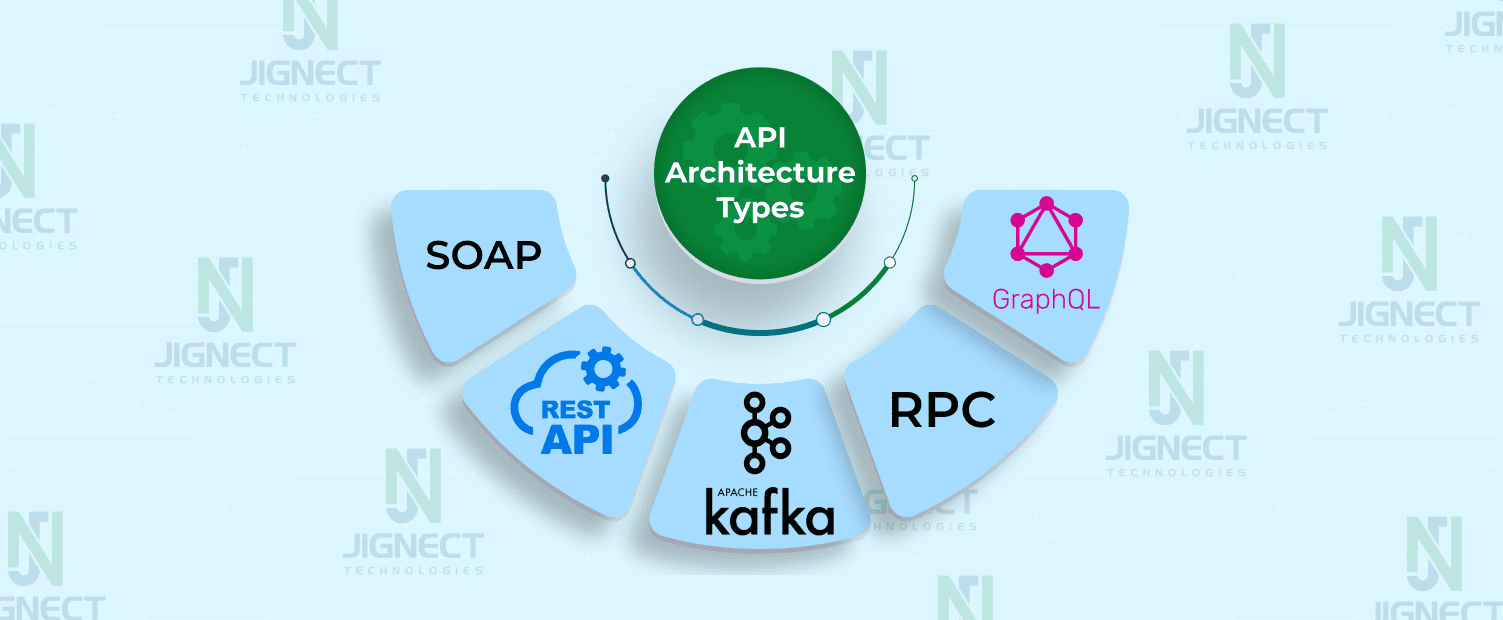An API, also known as an application programming interface, is a set of rules that define how applications or devices can connect to and communicate with each other. Here are various types of API architectures.
Table of Content
- Most commonly used API architectural types
- REST APIs
- SOAP APIs
- GraphQL APIs
- RPC API
- Apache Kafka
REST APIs :
Representational State Transfer (REST) is a widely used architectural style for designing networked applications. REST APIs are based on a set of principles that emphasize simplicity, scalability, and statelessness. They use standard HTTP methods (GET, POST, PUT, DELETE) to perform operations on resources identified by URLs. REST APIs are flexible and can be easily consumed by a variety of clients.
- Follows six REST architectural constraints
- Can use JSON, XML, HTML, or plain text
- Flexible, lightweight, and scalable
- Most used API format on the Web
- Uses HTTP
Read more about REST APIs : https://restfulapi.net/ & https://www.ics.uci.edu/~fielding/pubs/dissertation/rest_arch_style.htm
SOAP APIs :
Simple Object Access Protocol (SOAP) is another architectural style for building APIs. SOAP APIs use XML-based messages to exchange data between systems. They typically rely on a set of predefined XML schemas called Web Services Description Language (WSDL) to define the structure of requests and responses. SOAP APIs provide a more formal and structured approach to API development and is a prime example of soap architecture.
- Strictly defined messaging Framework that relies on XML
- Protocol independent
- Secure and extensible
- Used in secure enterprise environments
Read more about SOAP APIs : https://developer.salesforce.com/docs/atlas.en-us.api.meta/api/sforce_api_quickstart_intro.htm
GraphQL APIs :
GraphQL is a query language and runtime for APIs developed by Facebook. Unlike REST or SOAP, GraphQL allows clients to specify exactly what data they need, reducing over-fetching or under-fetching of data. With GraphQL, clients can send a single request to retrieve multiple resources or perform complex data manipulations. It provides a flexible and efficient way of building APIs that cater to specific client requirements.
- A query language for APIs
- Uses a Schema to describe data
- Functions using queries and mutations
- Uses a single endpoint to fetch specific data
- Used in apps requiring low bandwidth
Read more about GraphQL APIs : https://graphql.org/
RPC API :
An RPC is a Remote Procedure Call protocol. They are the oldest and simplest types of APIs. The goal of an RPC was for the client to execute code on a server. XML-RPC used XML to encode its calls, while JSON-RPC used JSON for the encoding. Both are simple protocols. Though similar to REST, there are a few key differences. RPC APIs are very tightly coupled, making it difficult to maintain or update them. To make any changes, a new developer would have to go through various RPCs’ documentation to understand how one change could affect the other.
- Action-based procedure great for command-based systems
- Uses only HIT GET and POST
- Has lightweight payloads that allow for high performance
- Used for distributed systems
Read more about RPC APIs : https://www.jsonrpc.org/specification
Apache Kafka :
The Apache Kafka API architecture provides a highly scalable, fault-tolerant, and distributed messaging system that can handle real-time data streams efficiently. It is widely used in modern data architectures for building event-driven applications, streaming platforms, and data integration pipelines. The Kafka API provides various programming interfaces, including Java, Scala, Python, and more, to interact with the Kafka cluster. It offers a rich set of features like message compression, batching, and configurable retention policies.
- Used for live event streaming
- Communicales over TCP protocol
- Can publish, store, and process data as it occurs
- Captures and delivers real time data e.g. Stock markets
Read more about Apache Kafka : https://kafka.apache.org/documentation/
In conclusion, APIs play a crucial role in modern software development, enabling seamless integration and communication between different systems. The choice of API architectural style depends on various factors, such as the requirements of the application, the type of data being exchanged, and the desired performance characteristics. REST, SOAP, GraphQL, RPC, and Apache Kafka are some of the most commonly used API architectural types, each with its own strengths and use cases. Understanding different API protocols and architectures is essential for optimizing your API strategy.

Apart from this there are many other API architecture types like
- WebSockets
- Webhooks
- MQTT (Message Queuing Telemetry Transport)
- EDI (Electronic Data Interchange)
- AMQP (Advanced Messaging Queuing Protocol)
Witness how our meticulous approach and cutting-edge solutions elevated quality and performance to new heights. Begin your journey into the world of software testing excellence. To know more refer to Tools & Technologies & QA Services.
If you would like to learn more about the awesome services we provide, be sure to reach out.
Happy Testing 🙂




